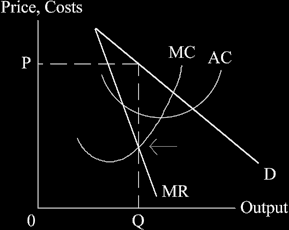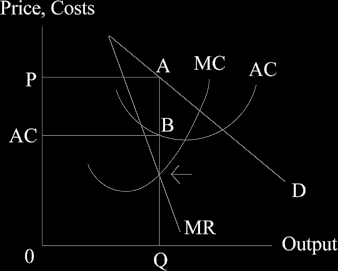Monopoly
(the left hand end of the arrow of competition)

(There is some overlap between Unit 2 and Unit 4 on monopoly, so this may seem familiar to you.)
WHAT IS A MONOPOLY
Definition: Technically it is a sole supplier, i.e., there is one firm in the industry. It is
the industry.
But there are degrees of monopoly - if one firm supplies, say, 80 per cent, it is close to a monopoly and will usually act like one.
Types of Monopoly
Economies of scale. One firm grows large, its cost curves are lower than the others, so it is able to sell more; in the end it grows to become the sole firm. This is the so-called natural monopoly.
2a) The law. The government may restrict the industry to one nationalised firm. An example was British Steel some decades ago in the UK.
2b) Regulations. A trade union may have a monopoly over the supply of one kind of labour – the British Medical Association covers all doctors for instance.
Agreement between firms, so that they all act together and behave as one monopolist. This is often illegal but it happens.
Exclusive ownership of a unique resource. As an example, all the known
supply of iron ore in Australia was once in the hands of a company called BHP; similarly De Beers diamond mining once virtually controlled all (and still controls a lot) of the international supply of diamonds.
Copyrights, patents and licences are particular forms of this exclusive ownership.
Marginal revenue and monopoly
Marginal revenue is the addition to total revenue from the last unit sold.
A perfectly competitive firm can sell as much as it wants at an unchanged price. Its MR curve is equal to the price – every time it sells one more item it receives, say, an additional 50 pence, which adds 50 pence to TR.
A monopolist is the industry, so it faces a normal downward sloping demand curve.
So if wants to sell more of the good or service it must lower the price.
And of course it must sell all its products at that lower price. This means it loses by selling the items it used to sell earlier at a higher price at the new lower price.
So the price of the marginal product is not the MR – the firm’s total revenue increases by less than this sale, because of the bit it lost on the price on all the other products.
See the example in the table below.
| AS INCREASE QUANTITY |
MUST LOWER PRICE (£) |
TOTAL REVENUE ALTERS (PxQ) (£) |
MARGINAL REVENUE (£) |
|---|---|---|---|
| 1 | 2 | 3 (1 x 2) | 4 (by subtraction in 3) |
| 1 | 7 | 7 | 7 |
| 2 | 6 | 12 | 5 (12-7) |
| 3 | 5 | 15 | 3 (15 -12) |
| 4 | 4 | 16 | 1 (etc) |
| 5 | 3 | 15 | - 1 |
| 6 | 2 | 12 | - 3 |
| 7 | 1 | 7 | - 5 |
Note that marginal revenue is less than price for all quantities after the first one.
Monopoly equilibrium
Equilibrium is where MC = MR, as usual. When you are drawing the diagram and answering questions you should locate that point first and draw it in.

Seeing monopoly profits in the diagram below
Profits = total revenue minus total cost. Total revenue = price times quantity. Total cost = average cost times quantity.
Total revenue = the area 0 P A Q. Total costs = the area 0 AC B Q.
So profit is the difference between these two areas = P A B AC.

Problems with monopoly, “what is wrong with monopoly” or "the welfare effects of monopoly"
A monopoly limits output and keeps price high.
A monopoly redistributes income from all the consumers to this one firm or person (an equity issue).
Monopolists may develop political and social power over others, which reduces the efficiency of democracy and is inequitable. There are political dangers of a few very rich and powerful people (Marx called them “monopoly capitalists” who misuse their position and exploit people).
A monopoly may behave badly in an anti-social way. For instance it may force out a rival firm by selling its product at give-away prices, well below cost and taking the short term loss. After it has forced out the competitor, it will then put the price back up again. This behaviour may or may not be legal. It depends on the country involved and its legislation but it is always reprehensible.
The lack of competition tends to promote inefficiency, the company rests on laurels, there is no need to try hard, and it lacks dynamism. This is probably the main criticism – said Austin Robinson
The result is lazy managers and owners.
This means that technical progress is reduced, leading to slow economic growth of the country and a lower standard of living than we could have.
Resources are misallocated. Too many go to the monopolist and they are not fully used by him. This is a waste for society and in addition, the price mechanism is prevented from working properly.
A monopoly reduces consumer choice. There is no one else to buy from and no other producer’s product.
A monopolist may ignore small market demands as he cannot be bothered to meet them. You will recall that I mentioned earlier that Henry Ford is supposed to have said about his motor cars “You can have any colour you want, as long
as it’s black”.
The long run effect from the existence of monopolies is slightly slower growth;
a lower standard of living; higher unemployment (because the monopolist restricts output and so requires fewer people); higher prices (which monopolies charge); a slightly poorer balance of payments as a result of this; a less equal income distribution; and poorer resource allocation.
Benefits of monopoly – there are not many really, but some case can be made.
A monopolist can use monopoly profits for research and development, leading to product improvement, faster growth, and lower costs, despite the argument above that they are inherently lazy.
- Joseph Schumpeter argued that they are important for innovation; he felt that big firms are the only ones that are able to afford the necessary laboratories, equipment and research staff.
- Against this, research exists that shows many of the breakthroughs come from small firms, for example Apple began making those computers in a garage.
Monopolists may be able to reap economies of scale, for example the Royal Mail; the provision of telephone lines; the supply of electricity; the supply of gas; and the provision of railways. Economies of scale mean lower costs (although the monopolist Royal Mail is notoriously inefficient in the new millennium).
A state monopoly may be safer than a private one. A private monopoly may be more tempted to cut corners and reduces necessary maintenance to lower costs, and this could be particularly serious in some areas like the railways or air traffic control.
A reminder: are you revising something and practicing drawing diagrams each day?